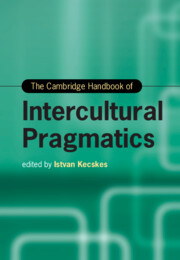Book contents
- The Cambridge Handbook of Intercultural Pragmatics
- Cambridge Handbooks in Language and Linguistics
- The Cambridge Handbook of Intercultural Pragmatics
- Copyright page
- Contents
- Figures
- Tables
- Acknowledgment
- Contributors
- Introduction The Rise of Intercultural Pragmatics
- Part I Theoretical Foundation
- Part II Key Issues in Intercultural Pragmatics Research
- Part III Interface of Intercultural Pragmatics and Related Disciplines
- Part IV Intercultural Pragmatics in Different Types of Communication
- 21 Visual and Multimodal Communication across Cultures
- 22 Intercultural Teamwork via Videoconferencing Technology: A Multimodal (Inter)action Analysis
- 23 Intercultural Communication in Computer-Mediated Discourse
- 24 Intercultural Aspects of Business Communication
- 25 Intercultural Pragmatics in Healthcare Communication
- 26 Academic and Professional Discourse in Intercultural Pragmatics
- 27 The Dynamic Model of Meaning Approach: Analyzing the Interculturality of Conspiracy Theory in Far-Right Populist Discourses
- Part V Language Learning
- Index
- References
23 - Intercultural Communication in Computer-Mediated Discourse
from Part IV - Intercultural Pragmatics in Different Types of Communication
Published online by Cambridge University Press: 29 September 2022
- The Cambridge Handbook of Intercultural Pragmatics
- Cambridge Handbooks in Language and Linguistics
- The Cambridge Handbook of Intercultural Pragmatics
- Copyright page
- Contents
- Figures
- Tables
- Acknowledgment
- Contributors
- Introduction The Rise of Intercultural Pragmatics
- Part I Theoretical Foundation
- Part II Key Issues in Intercultural Pragmatics Research
- Part III Interface of Intercultural Pragmatics and Related Disciplines
- Part IV Intercultural Pragmatics in Different Types of Communication
- 21 Visual and Multimodal Communication across Cultures
- 22 Intercultural Teamwork via Videoconferencing Technology: A Multimodal (Inter)action Analysis
- 23 Intercultural Communication in Computer-Mediated Discourse
- 24 Intercultural Aspects of Business Communication
- 25 Intercultural Pragmatics in Healthcare Communication
- 26 Academic and Professional Discourse in Intercultural Pragmatics
- 27 The Dynamic Model of Meaning Approach: Analyzing the Interculturality of Conspiracy Theory in Far-Right Populist Discourses
- Part V Language Learning
- Index
- References
Summary
Political and economic globalization, together with constant technological advances, has resulted in unprecedented levels of international human mobility. As a result, societies are increasingly intercultural. Nowhere is this interculturality more pervasive than in digital discourse (traditionally known as computer-mediated communication or CMC), where interlocutors from different cultural backgrounds may interact on global platforms and social networking sites such as Twitter, Instagram, or YouTube, to name but a few. Intercultural communication, however, poses interlocutors with serious challenges to overcome, such as differences in their value systems, and diverging communication styles and behaviours. All of them can easily lead to miscommunication and conflict between cultural groups, both within and across societies, as well as the perpetuation of cultural stereotypes. Yet, most research on CMC to date has focused on monocultural studies or cross-cultural comparisons while intercultural communication in CMC is still rather under-researched. Keeping the above in mind, the present chapter aims to review the research that has been carried out so far in the field of digital discourse with a special focus on intercultural communication, as well as to provide readers with avenues for future research in this burgeoning field.
Keywords
- Type
- Chapter
- Information
- The Cambridge Handbook of Intercultural Pragmatics , pp. 588 - 611Publisher: Cambridge University PressPrint publication year: 2022
References
- 1
- Cited by

